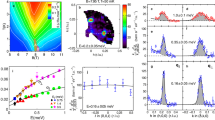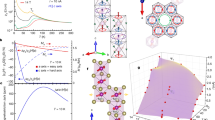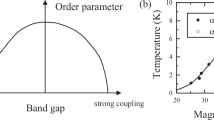Abstract
Near a Mott transition1, which can be tuned by controlling either the charge-carrier density (‘filling’) or the correlation strength (‘bandwidth’), lies fascinating emergent behaviour, such as unconventional superconductivity2,3, and the understanding of the underlying Mott criticality is a longstanding challenge. Recent studies have showed that the bandwidth-controlled Mott criticality (BCMC) involves critical fluctuations in charge4,5 and lattice6,7 degrees of freedom. Spin is another degree of freedom and its antiferromagnetic fluctuations are ubiquitous in strongly correlated electrons8,9. However, the magnetic aspects of BCMC are unexplored. Here, we report on the magnetic criticality brought about by BCMC. Through NMR investigations on a κ-type organic salt, we observe critical suppression of antiferromagnetic fluctuations accompanied by the critical enhancement of conductance. The two criticalities show the same exponent within experimental error. Site-to-site electron hopping introduces doubly occupied and empty sites, which extinguish stroboscopically the local spins, probably resulting in the identical criticality in charge and spin.
This is a preview of subscription content, access via your institution
Access options
Subscribe to this journal
Receive 12 print issues and online access
$259.00 per year
only $21.58 per issue
Buy this article
- Purchase on SpringerLink
- Instant access to full article PDF
Prices may be subject to local taxes which are calculated during checkout





Similar content being viewed by others
References
Mott, N. F. Metal–Insulator Transitions (Taylor & Francis, 1990).
Timusk, T. & Statt, B. The pseudogap in high-temperature superconductors: An experimental survey. Rep. Prog. Phys. 62, 61–122 (1999).
Nam, M.-S., Ardavan, A., Blundell, S. J. & Schlueter, J. A. Fluctuating superconductivity in organic molecular metals close to the Mott transition. Nature 449, 584–587 (2007).
Limelette, P. et al. Universality and critical behavior at the Mott transition. Science 302, 89–92 (2003).
Kagawa, F., Miyagawa, K. & Kanoda, K. Unconventional critical behaviour in a quasi-two-dimensional organic conductor. Nature 436, 534–537 (2005).
Founier, D., Poirier, M., Castonguay, M. & Truong, K. Mott transition, compressibility divergence, and the P–T phase diagram of layered organic superconductors: An ultrasonic investigation. Phys. Rev. Lett. 90, 127002 (2003).
Souza, de M. et al. Anomalous lattice response at the Mott transition in a quasi-2D organic conductor. Phys. Rev. Lett. 99, 037003 (2007).
Millis, A. J., Monien, H. & Pines, D. Phenomenological model of nuclear relaxation in the normal state of YBa2Cu3O7 . Phys. Rev. B 42, 167–178 (1990).
Yusuf, E., Powell, B. J. & McKenzie, R. H. Antiferromagnetic spin fluctuations in the metallic phase of quasi-two-dimensional organic superconductors. Phys. Rev. B 75, 214515 (2007).
Kanoda, K. Recent progress in NMR studies on organic conductors. Hyperfine Interact. 104, 235–249 (1997).
Kino, H. & Fukuyama, H. Phase diagram of two-dimensional organic conductors: (BEDT-TTF)2X. J. Phys. Soc. Jpn 65, 2158–2169 (1996).
Lefebvre, S. et al. Mott transition, antiferromagnetism, and unconventional superconductivity in layered organic superconductors. Phys. Rev. Lett. 85, 5420–5423 (2000).
Limelette, P. et al. Mott transition and transport crossovers in the organic compound κ-(BEDT-TTF)2Cu[N(CN)2]Cl. Phys. Rev. Lett. 91, 016401 (2003).
Kagawa, F., Itou, T., Miyagawa, K. & Kanoda, K. Transport criticality of the first-order Mott transition in the quasi-two-dimensional organic conductor κ-(BEDT-TTF)2Cu[N(CN)2]Cl. Phys. Rev. B 69, 064511 (2004).
Kagawa, F., Itou, T., Miyagawa, K. & Kanoda, K. Transport criticality of the first-order Mott transition in the quasi-two-dimensional organic conductor κ-(BEDT-TTF)2Cu[N(CN)2]Cl. Phys. Rev. Lett. 93, 127001 (2004).
Ohashi, T., Momoi, T., Tsunetsugu, H. & Kawakami, N. Finite temperature Mott transition in Hubbard model on anisotropic triangular lattice. Phys. Rev. Lett. 100, 076402 (2008).
Park, H., Haule, K. & Kotliar, G. Cluster dynamical mean field theory of the Mott transition. Phys. Rev. Lett. 101, 186403 (2008).
Kotliar, G., Lange, E. & Rozenberg, M. J. Landau theory of the finite temperature Mott transition. Phys. Rev. Lett. 84, 5180–5183 (2000).
Imada, M. Universality classes of metal–insulator transitions in strongly correlated electron systems and mechanism of high-temperature superconductivity. Phys. Rev. B 72, 075113 (2005).
Georges, A., Kotliar, G., Krauth, W. & Rozenberg, M. J. Dynamical mean-field theory of strongly correlated fermion systems and the limit of infinite dimensions. Rev. Mod. Phys. 68, 13–125 (1996).
Kotliar, G. & Vollhardt, D. Strongly correlated materials: Insights from dynamical mean-field theory. Phys. Today 57, 53–59 (2004).
Sasaki, T., Yoneyama, N., Kobayashi, N., Ikemoto, Y. & Kimura, H. Imaging phase separation near the Mott boundary of the correlated organic superconductors κ-(BEDT-TTF)2X. Phys. Rev. Lett. 92, 227001 (2004).
Dumm, M. et al. Bandwidth-controlled Mott transition in κ-(BEDT-TTF)2Cu[N(CN)2]BrxCl1−x: Optical studies of correlated carriers. Phys. Rev. B 79, 195106 (2009).
Kobashi, K. Transport Properties Near the Mott Transition in the Quasi-Two-Dimensional Organic Conductor κ-(ET)2X. Thesis, Univ. Tokyo (2007).
Papanikolaou, S. et al. Universality of liquid-gas Mott transitions at finite temperatures. Phys. Rev. Lett. 100, 026408 (2008).
Brinkman, W. F. & Rice, T. M. Application of Gutzwiller’s variational method to the metal–insulator transition. Phys. Rev. B 2, 4302–4304 (1970).
Faltermeier, D. et al. Bandwidth-controlled Mott transition in κ-(BEDT-TTF)2Cu[N(CN)2]BrxCl1−x: Optical studies of localized charge excitations. Phys. Rev. B 76, 165113 (2007).
Merino, J., Dumm, M., Drichko, N., Dressel, M. & McKenzie, R. H. Quasiparticles at the verge of localization near the Mott metal–insulator transition in a two-dimensional material. Phys. Rev. Lett. 100, 086404 (2008).
De Soto, S. M. et al. 13C NMR studies of the normal and superconducting states of the organic superconductor κ-(ET)2Cu[N(CN)2]Br. Phys. Rev. B 52, 10364–10368 (1995).
Kagawa, F., Kurosaki, Y., Miyagawa, K. & Kanoda, K. Field-induced staggered magnetic moment in the quasi-two-dimensional organic Mott insulator κ-(BEDT-TTF)2Cu[N(CN)2]Cl. Phys. Rev. B 78, 184402 (2008).
Acknowledgements
We thank S. Watanabe, M. Imada, J. Fujioka and Y. Takahashi for fruitful discussion. This work was partially supported by Grant-in-Aids for Scientific Researches on the Priority Area (Grant No. 17071003) and on Innovative Area (Grant No. 20110002) from the MEXT, a Grant-in-Aid for Scientific Research (Grant Nos 20244055 and No. 20540346) from the JSPS and the Global COE Program: Global Center of Excellence for the Physical Sciences Frontier.
Author information
Authors and Affiliations
Contributions
F.K., K.M. and K.K. designed the experiments. F.K. carried out the experiments and analysed the data. F.K. and K.K. interpreted the data. K.M. grew the single crystals for the study. F.K. wrote the paper with assistance from K.K. and K.M.
Corresponding author
Supplementary information
Supplementary Information
Supplementary Information (PDF 537 kb)
Rights and permissions
About this article
Cite this article
Kagawa, F., Miyagawa, K. & Kanoda, K. Magnetic Mott criticality in a κ-type organic salt probed by NMR. Nature Phys 5, 880–884 (2009). https://doi.org/10.1038/nphys1428
Received:
Accepted:
Published:
Issue date:
DOI: https://doi.org/10.1038/nphys1428
This article is cited by
-
Spin-orbital entangled molecular jeff states in lacunar spinel compounds
Nature Communications (2014)
-
Superconducting fluctuations in organic molecular metals enhanced by Mott criticality
Scientific Reports (2013)
-
The problem with spins
Nature Physics (2009)



